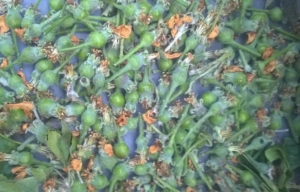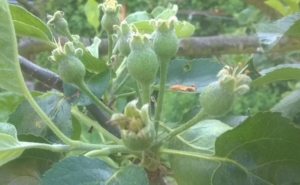God Save the King
Fruiting spurs on apple trees push out six buds in the spring. The center bud blooms first and will become the largest fruit – the King Blossom! When we thin fruitlets, we usually save the King and discard the others.
There are times when we don’t save the King. You may not want big apples! Or, thinning with discipline, you stick to the rule of one fruit for every six inches of branch. Too many fruit on the tree can lead to poor apple quality this year and to a small floral set for next year (alternate bearing).
Last week, Lyr was willing to thin the Liberty apple tree. The Liberty apples are tricky because the stem is very short and fat. I advised them, “Keep one per cluster, but, if space is tight, one per six inches”. Armed with a sharp pair of fingernail scissors, away they went.
I got back to laying brick, as fast as I could go before the mortar set. Soon Lyr came over with a leaf and asked, “What’s this?”
I think of the pests that eat the apple blossoms. Lyr probably has a silken cocoon with 40 nasty little  oblique-banded leafrollers (Choristoneura roseceana ) squirming around.
oblique-banded leafrollers (Choristoneura roseceana ) squirming around.
No. On the leaf is some tiny bug shaped like a football helmet. “Oh”, I respond, setting a brick, “I have no idea. It’s a small bug.”
I also gave Lyr a small mirror so that they can check the back of the fruitlet for a strike of some kind, without having to handle the fruit. (No sense keeping an apple that already has a bite out of it … King or no King.)
Lyr is a nature lover. You know, the frog in their pocket type. Always picking up some little critter and wondering what it is. Lyr walks over to us again.
“What’s this?”, they ask. Perhaps this time they have a winter moth larvae (Operophtera brumata ) or Bud moth larvae (Spilonota ocellana). I scrape off some mortar and take a glance. I see nothing.
“Can you see it?”, Lyr asks.
I look closer. “Uh, you mean that tiny 2 millimeter thing?”, I ask. I struggle to be concerned, knowing that, whatever it is, it won’t destroy our fruit.
 Lyr has the presence and focus it takes to do any task. They quickly learn the quirks: Cut the fruitlet that is next to a branch that will squish the apple when it sizes up. Eliminate the one that will get less sun than another. If your tree has a very small fruit set, you might keep two per cluster. (In this case, take out the middle fruit to allow more space for the two laterals.) Keep fruit that has a thick stem; these may be less vulnerable to “June fruit drop”. And, when thinning a fruitlet, clip off the whole stem to facilitate tying a nylon footie to the remaining apple.
Lyr has the presence and focus it takes to do any task. They quickly learn the quirks: Cut the fruitlet that is next to a branch that will squish the apple when it sizes up. Eliminate the one that will get less sun than another. If your tree has a very small fruit set, you might keep two per cluster. (In this case, take out the middle fruit to allow more space for the two laterals.) Keep fruit that has a thick stem; these may be less vulnerable to “June fruit drop”. And, when thinning a fruitlet, clip off the whole stem to facilitate tying a nylon footie to the remaining apple.
Lyr is finished. FECO and the Liberty tree are lucky to have such good help!
Ruth
further reading:
Fruit Thinning for High Quality
By G.A. Moulton and J. King, WSU – Mount Vernon
no date
link: https://extension.wsu.edu/maritimefruit/fruit-thinning-for-high-quality/
It’s great to be the King: Apple fruit development affected by the position in the cluster
Chair for Fruit Growing, Viticulture and Vegetable Growing, Department of Agronomy, Biotechnical Faculty, University of Ljubljana, Jamnikarjeva 101, SI-1000 Ljubljana, Slovenia
8 August 2015, Version of Record 8 August 2015.
https://www.sciencedirect.com/science/article/abs/pii/S0304423815301229


Lyr’s first 3mm bug is significant. For breakfast, lunch and dinner it eats nothing but powdery mildew! Hurrah!!
Psyllobora vigintimaculata (Twenty-spotted Lady Beetle) species correction welcome
http://10000thingsofthepnw.com/2020/09/25/psyllobora-vigintimaculata-twenty-spotted-lady-beetle/
Thanks, Ruth. Very helpful.